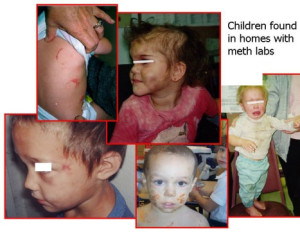 Methamphetamine is a highly addictive psychoactive stimulant that produces an intensely euphoric high, with a “crash” that causes depression, irritability, insomnia, nervousness, and paranoid aggressive behaviors (ONDCP, 1999)—all of which present a risk of serious neglect and abuse to the children of meth-dependent parents. Many children who survive abuse or neglect are angry, antisocial, physically aggressive, and even violent (Dunn et al., 2002; Thompson, 1998). They may perform poorly in school and engage in delinquent behavior (Dembo et al., 1988; Hildyard & Wolfe, 2002). For some, the consequences include low self-esteem, depression, hopelessness, suicide attempts, and self-mutilation (Dube et al., 2001). They may behave compulsively, suffer panic attacks, be highly distrustful of others, and tend toward dangerous play and sexual promiscuity (Brohl, 1996; Kang, Deren, & Goldstein, 2002). These children are also at high risk to continue intergenerational patterns of drug abuse, criminal behaviors, and neglectful parenting (Dunn et al., 2002; Sheridan, 1995).
Methamphetamine is a highly addictive psychoactive stimulant that produces an intensely euphoric high, with a “crash” that causes depression, irritability, insomnia, nervousness, and paranoid aggressive behaviors (ONDCP, 1999)—all of which present a risk of serious neglect and abuse to the children of meth-dependent parents. Many children who survive abuse or neglect are angry, antisocial, physically aggressive, and even violent (Dunn et al., 2002; Thompson, 1998). They may perform poorly in school and engage in delinquent behavior (Dembo et al., 1988; Hildyard & Wolfe, 2002). For some, the consequences include low self-esteem, depression, hopelessness, suicide attempts, and self-mutilation (Dube et al., 2001). They may behave compulsively, suffer panic attacks, be highly distrustful of others, and tend toward dangerous play and sexual promiscuity (Brohl, 1996; Kang, Deren, & Goldstein, 2002). These children are also at high risk to continue intergenerational patterns of drug abuse, criminal behaviors, and neglectful parenting (Dunn et al., 2002; Sheridan, 1995).
Children who live in home-based meth labs are not only exposed to their parents’ chaotic and drug-focused lifestyles, but also to the highly psychoactive stimulant and the toxic precursor chemicals associated with meth production. Exposure to these chemicals is known to cause severe health problems in adults, and can cause death from accidental ingestion. However, long-term affects of the chemical exposure on children remain unknown (Kolecki, 1998). Clearly, the combination of exposure to the toxic effects of the drug itself and to the aberrant behavior of the adult meth users puts children living in these settings in a uniquely dangerous and damaging environment. However, currently no data exist to measure the impact of this circumstance.
Links:
